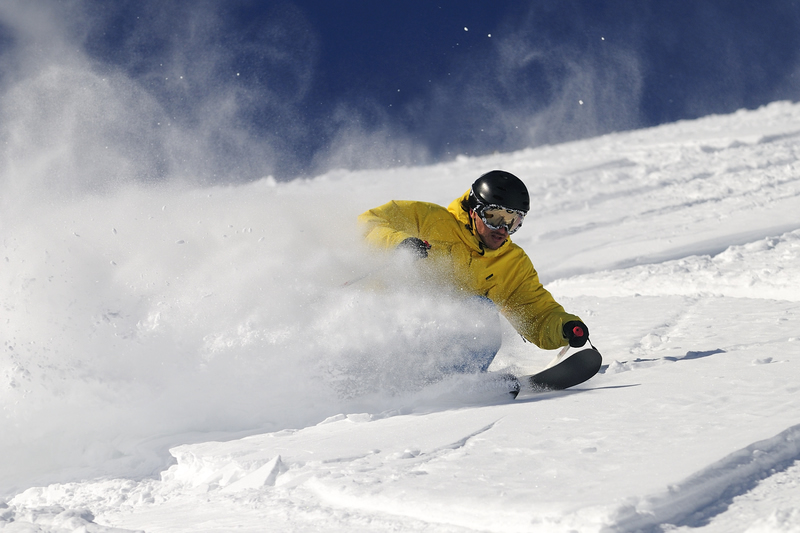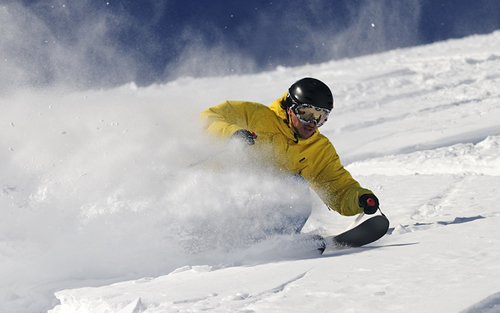You can’t consider yourself a complete golfer if you can’t put every club in the bag to good use. Skiers also have a bag of clubs, not in the sense of having 14 skis from which to choose, but in the arsenal of turn shapes and turning techniques that can be deployed in any given circumstance.
The first “club” we learn to use is the humble snowplow, and for however long we ski that club always remains in the bag, ready to pull out for rapid deceleration on a cat-track or when coming in hot to the liftline. A related club is the venerable sideslip, a slightly cockeyed slide that is skiing’s form of tiptoeing. These basic maneuvers may not be glamorous, but no skier can do without them.
The first club of major consequence we’re told to master is carving a turn, a combination of tipping and bending actions that set the ski on edge for a controlled trajectory. Just like the driver in golf, skiers can spend their lifetime trying to bring this club under control without consistent success. This tends to reduce the number of other clubs that can be added to the collection, but it need not keep us from enjoying the game.
There’s no question that carving is the primordial skill of high-level skiing, but just as racing is no longer the lone pinnacle occupied by the sport’s elite, the fully laid-over arc isn’t the only avatar of excellence. The obvious alternative talent is carving’s antipode, the surfing style made possible with the arrival of super-fat skis. If you’re riding a 130mm wide ski with a reverse sidecut, resorting to carving technique isn’t going to prove very satisfactory. You need to add a smeared, low-angle turn to the bag to excel in super-deep conditions.
With the advent of near omnipresent grooming, not many people ski moguls anymore, or least not many ski them well. Good mogul technique comes in more than one iteration, depending on the speed and line selected, but if you’re going to rip a zipper line, you’re going to have to add another club to your game.
Long before anyone dug a half-pipe out of the earth, skiers were changing direction via the friction-free route of the aerial turn. The entire world of freestyle skiing was inspired by the impulse to mix skiing with air time, and they still go together like gin and tonic, whether in a manufactured terrain park or the one provided by nature on big mountains. If you’ve never left the ground to make a turn, you’re not playing with a full set of clubs.
Occasionally one encounters a mercifully rare condition where the usual methods won’t work. Such a moment occurs when confronted with a long exposure of breakable wind-crust. On a narrow ski, the best way through it is the old punch-and-rip technique, an explosive exercise that would look weirdly out of place in any other context, but gets the job done is this delicate set of circumstances.
If you add in all the ways that ballet skiers figured out to change directions, you could easily exceed the 14-club limit: the worm turn, the shoulder roll, the outrigger, the Charleston, the Shea-guy, the tip roll, the list could fill a page.
Back when the DesLauriers and Egan brothers were conducting Xtreme camps, I occasionally served as substitute coach if one brother or other were out of commission. At one session at Targhee, a technically skilled female skier asked me how to develop more variety in her skiing and thereby ascend to a higher level. My reply, which I’m not sure would be sanctioned by official writ, was that her skiing was too controlled, in a way too perfect, too dependent on sticking to textbook technique.
To help shake up her skiing, I advised her to let her skis run in rhythm with the terrain. Don’t worry about compulsively making that next turn. Get your feet apart and be ready to shift weight at any time. I told her to tuck in right behind me and took off on an aggressive line through broken snow and scrub pines. Being allowed to ski a little ragged was liberating for this already talented lass. She learned to ski the mountain and not just make turns.
To fully extract all of skiing’s pleasures, it pays to learn every which way to turn. There are all kinds of ways to pull off this feat, just as there are many forms of bliss. The motivation behind all the methods that require some learning is a desire to move with the flow, to find a connection with the energy that pours down every mountain and make some small part of it our own.


